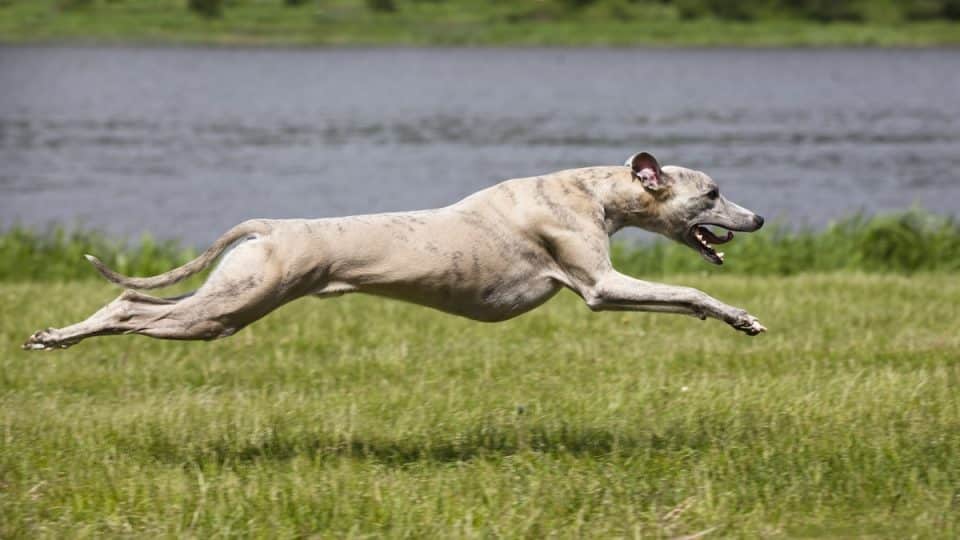- Not a substitute for professional veterinary help.
While there are many fast dogs in the world, the Greyhound is by far the fastest. Over a distance of 100 meters, male Greyhounds are capable of reaching speeds up to 45 miles per hour, while females can hit 41 mph.
Greyhounds are so fast they leave even famously speedy dog breeds, like the Border Collie and the German Shepherd, in the dust. These powerful working pups achieve speeds closer to 30 mph. And while Greyhounds might be popularly known as sprinters rather than endurance runners, they can still sustain a speed of 35 mph for as much as seven miles.
So what makes Greyhounds so fast, and how do they compare to the other sprinters of the animal kingdom? Read on!
Why Are Greyhounds So Fast?
The Greyhound’s anatomy makes them built for speed. They have a deep chest, large heart, flexible spine, and streamlined build.
“Greyhounds can get up to 45 mph generally within three or four strides,” says Anne Soeder of Greyhound Pet Adoption Northwest. “If you look at a Greyhound run in slow motion, there are two times when a Greyhound’s feet are completely off the ground. That generally doesn’t happen with other breeds of dogs.”
Breeding has only reinforced a Greyhound’s ability to run. As sighthounds, Greyhounds were originally bred for a sport called coursing, where the dog chases down game by sight rather than scent. Greyhounds are masters of sight hunting, and not just because of their speed. They also have an incredible 270-degree field of vision—while humans only have 180-degree vision.
In the early 20th century, Greyhound racing emerged as a spectator sport, and dedicated racing tracks were built to facilitate competitions.
Greyhounds Vs. Cheetahs and Other Animals
Greyhounds are fast—but they aren’t the fastest animals out there. A lot of the big cat species can outstrip a Greyhound over short distances, as can horses and pronghorns.
Greyhounds, do, however, have humans beat. Sprinter Usain Bolt set his 100-meter world record in 2009 by running at 23.35 mph, finishing in 9.58 seconds. At one point in the race, Bolt was clocked at 27.33 mph. In 2001, a Greyhound named Brett Lee ran the same distance in just 5.33 seconds.
| Animal | Speed |
| Cheetah | 68 to 75 mph |
| Pronghorn | 55 mph |
| Lion | 50 mph |
| Male Greyhound | 45 mph |
| White-tailed deer | 40 mph |
| Usain Bolt | 27.33 |
Record-breaking Greyhounds
The title of “fastest Greyhound” can vary depending on factors such as the race length and track surface. The Guinness Book of World Records lists Star Title as the fastest Greyhound, reaching 41.83 mph on a straightaway track on March 5, 1994, at Wyong, New South Wales, Australia.
Fernando Bale, an Australian Greyhound, holds the record for the fastest overall race time. He dashed to a new world record of 29.12 seconds in a 515-meter race at Angle Park, South Australia. Right behind him is Shakey Jakey, who ran a 535-meter race in 29.07 seconds.
Caring for a Former Racing Greyhound
Greyhounds are gentle, sensitive, and eager to please, so they are a good choice if you’re looking to adopt a sighthound. A common misconception is that Greyhounds are high-energy dogs because they are racing dogs, but the opposite is true. They don’t need a lot of exercise and are quite content to lie around the house napping—conserving their energy for the chase.
Soeder says Greyhounds as a breed have few serious health issues, but she advises people to be aware that they have especially thin skin. “They might get caught and get an injury from going past a rose bush or a stick sticking out or something like that,” she explains.
This, paired with their low body fat, makes them sensitive to heat and cold. Many enjoy a dog sweater in the colder months. They are typically low-maintenance dogs, needing few baths—though they do need regular nail clipping and ear cleaning.
Greyhounds must be leashed outdoors unless in a secure area with 6-foot fences. These sight hounds can see up to half a mile and will be gone in an instant if they spot something of interest. It’s part of their charm!




